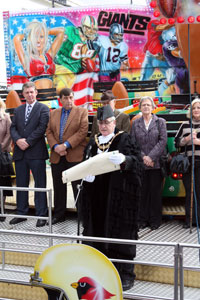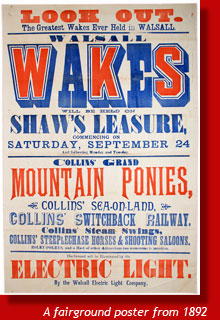



- Guild Notices
- The Showmen's Guild
- Midland Section
- History of Fairs
- Midland Section Fairs
- Guild Rules
- Community
- Contact Us
- Education



It was trade that was to become the more important element following the Norman Conquest, when those English fairs that were then in existence were reconstituted along French lines. Charters granted by the monarch gave fairs a legal status and an increasing importance in the economic life of the nation. In the 13th and 14th centuries almost 5000 fairs were chartered, the largest of these attracting merchants and a wealth of goods from many parts of Europe.
These fairs became important landmarks in the calendar, both socially and culturally. As well as drawing traders they were magnets for itinerant entertainers: jugglers, tumblers and musicians – the ancestors of today’s travelling showmen. A new dimension was added to the annual fair after the Black Death, the plague that killed over a third of the population. With fewer hands to work the land, wages rose steeply. Alarmed by this breach in the feudal system, Edward III sought to control wages by enacting a statute that would fix rates of pay. These fixed rates were to be announced at the annual fair – the one occasion when most of the local population would be present – or at specially called events. These latter events, ‘statute fairs’, eventually became the places where labourers could offer themselves for hire.
By the early 18th century the trading aspect of the chartered fairs had waned and some fairs, such as the famous Bartholomew Fair in London, were devoted entirely to pleasure and amusement. It was around this time that the first fairground rides, simple hand-turned roundabouts or swingboats, appeared. However, the shows were still the main attractions and would remain so until, in the 1860s, the King’s Lynn engineer Frederick Savage devised a successful method of driving roundabouts by steam power.
Savage's ingenuity transformed the showman’s business. Freed from the limitations of muscle power roundabouts could be made larger, more heavily ornamented – and more capacious. By the end of the 19th century the fairs were dominated by an astonishing array of steam-driven rides. Only the invention of moving pictures in 1896 – an innovation seized upon by the travelling showmen – saw a temporary halt in the decline of the shows. For most people their first experience of ‘the flicks’ was through the fairground Bioscope shows. Likewise, for many country folk, their first sight of electric lighting was at the local fair.
The story of the fair is one of continuous development. Novelty – the showman’s stock-in-trade – is the vital element in attracting the public’s custom. Fairs may have changed over the years but their purpose remains the same: to provide the fairgoer with a form of entertainment that is unpretentious, inclusive and uninhibited.